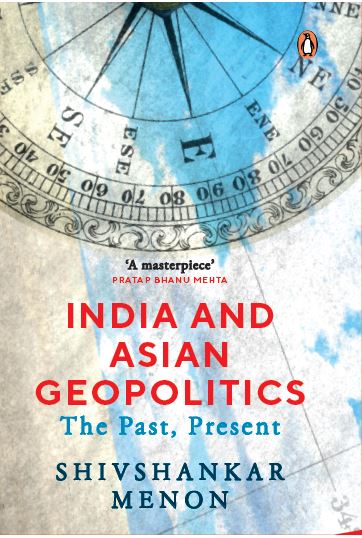Chapter 1: page 16-18
“The postmodernists would like us to believe that Indian history is what we make it or are the narratives that we choose to tell ourselves and believe. I beg to differ. History is like a map, an imperfect reflection of a larger objective reality that, over time and with improvements in the historian’s art, becomes clearer and more representative of an objective reality that did exist and certainly seemed to exist to earlier generations in history. That map is important to us in looking at India’s foreign and security policies because we choose, decide, and act on the basis of the map of our own experience, or the history, that we carry in our heads. Perception matters. And when perception does not match objective reality, policy errs or fails.
The problem is that several generations in India have been taught a version of history that ignores that India has for much of its past been well connected to the world and its prosperity and security have waxed and waned in direct proportion to that link. That may be because the regions that undertook these contacts with the rest of the world, what historians call coherent core areas, that is, areas characterized by stable, long-term political and cultural institutions, such as Bengal and Gujarat and the Malabar and Coromandel coasts, have been ignored or downplayed in these historical narratives in favor of the relatively insular Indo-Gangetic plain and the region around Delhi, partly because a version of Indian history written by those loyal to the British empire dominated the field. It is only in the last few years that younger scholars have begun to study these less recognized regions seriously.
The simplistic history written by historians loyal to the British empire legitimized British rule by making Indian history a continuous sequence of alien empires and conquerors. This saga of empires was periodized by religion, and caste was emphasized, disregarding the fact that the ruling elite was always of mixed religious persuasion and origins, and that assimilation and social mobility were both possible and practiced.
It amazes me that some Indians—despite having been shown alternative and more cogent lines of enquiry—persist in this religious characterization and accept the simplified history foisted on us. Certain historians and writers in India still contribute to the misrepresentation of India in history as an autonomous world apart, driven by religion and its own logic, and different from the rest of the world. One has only to look at the practice and the linkages with the world of the Mauryas, Kushanas, Guptas, Delhi Sultanate, and Moghuls to see how misleading this representation is. And these entities were carrying on a tradition of engagement stretching from the Indian subcontinent to the Middle East, the Roman empire and the Mediterranean Sea, central Asia, China, and southeast Asia inherited from the Indus valley civilization in the third and second millennium BCE. India was not “a world apart,” but a complex civilization involved in myriad exchanges—of goods, ideas, and peoples—with the surrounding world.
But this is only one part of India’s true geopolitical inheritance. Kalidasa described the ideal rulers of the Raghukula as asamudra kshitiesanam, or those whose territories extended to the sea shore. The Satavahanas used the title Trisamudrapati, or Lords of the Three Seas. Including the history of the other regions in our consideration gives us a very different historical legacy that forms an increasingly important element of our strategic culture and driver of our policy choices. If you see Indian history as Delhi-centered, you will make the mistake that many of us make, of believing, as K. M. Panikkar said, that “India has, throughout history, had trouble arousing much interest in the world beyond its borders,” which he contrasted to British attentiveness to developments around the Raj. The coastal tradition in India, on the other hand, has seen outward projections of power, influence, and culture throughout its history.
Once you include southern and western India and Bengal and Orissa, the strength of India’s links with the rest of the world, going back to 2600 BCE, become clear. Ptolemy attests to this in the second century CE, while Pliny in mid-first century CE grumbles about gold and silver draining away to India from the Roman empire for luxury goods, a problem that the British also had in the early days of trading with India, until they discovered the uses of opium.
The reach and extent of the soft and hard power of non-Gangetic regions of India in both mainland and archipelagic southeast Asia are visible to this day in the great ruins of Angkor Wat and Borobudur, on the walls of the Vaikuntha Perumal temple in Kanchipuram and in Hampi, and in the living culture of our countries. The Cholas’ activist external policies and willing militarism enabled them to last from the third century BCE to the thirteenth century CE, longer than any dynasty in the Gangetic valley. Their example was actively followed by the Pandyan (sixth century BCE to twelfth century CE) and Pallava (third to ninth century CE) dynasties. The same is also true of the reach and influence of some Gangetic or Indus valley-based political entities like the Mauryas or Kushanas as the spread of Buddhism overland to the Pacific and the Mediterranean attests. Vijayanagara flourished and grew prosperous on its trade with central, west, and southeast Asia. The Mughals, for their part, played an active role in central Asian politics, too. This is a strong, continuous, and abiding legacy of engagement beyond the subcontinent. As long as the Indian Ocean was an open, competitive space, peninsular India was relatively secure. The Mughals punished the Portuguese for piracy by limiting their activity on land, advantaging their competitors, the English, French, Dutch, and Danes. When Britain managed a relative monopoly on trade in the Indian Ocean following the Carnatic Wars with the French, it became possible for Britain to translate maritime control into predominance on land.”
Shivshankar Menon is an Indian diplomat, who has served as the National Security Advisor to the Indian Prime Minister from January 2010 to May 2014. He has previously served as the Foreign Secretary of India (2006-09), High Commissioner of India to Sri Lanka (1997-2000), and Pakistan (2003-06) as well as Ambassador of India to Israel (1995-97), and China (2000-2003). He is the author of “Choices: Inside the Making of Indian Foreign Policy” (2016), and “India and Asian Geopolitics: The Past, Present” (2021). He is currently a Visiting Professor at Ashoka University.
We publish all articles under a Creative Commons Attribution-Noderivatives license. This means any news organisation, blog, website, newspaper or newsletter can republish our pieces for free, provided they attribute the original source (OpenAxis).







